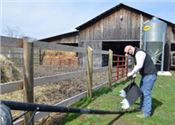|
UK Extension Helps Livestock Producers Deter Black Vultures

Johnson County farmer Tyler Ferguson hangs his black vulture effigy on an old basketball goal post.
Photo courtesy of Katie Pratt, UK Agricultural Communications
LEXINGTON, KY.
Black vultures are a concern for livestock producers throughout Kentucky, particularly this time of the year, as they can kill newborn calves and other juvenile livestock. University of Kentucky College of Agriculture, Food and Environment faculty and staff are working with Kentucky producers to find low-cost, legal options to control these birds and prevent livestock losses.
Controlling black vultures is challenging, because they are protected by the 1918 Migratory Bird Treaty Act. This act makes it illegal to kill them without a valid federal permit. A highly intelligent bird, the vulture is difficult to kill even with a valid permit.
It’s their intelligence that Matt Springer, UK assistant extension professor for wildlife management, is hoping to use to control them. Springer and his graduate student Jonathan Matthews designed an effigy of a black vulture using a rubber stall mat and specifications from similar designs developed by the U.S. Army Corps of Engineers and the U.S. Department of Agriculture’s Wildlife Services. An effigy is an image or representation of a particular species.
The idea is if black vultures see the effigy of the bird hanging upside down from a high post or tree, they will assume it’s an actual dead bird and stay away from the area. The effigy is inexpensive and easy to make with materials costing under $30 and taking about two hours to complete.
“There is not a lot of research in this area, but we do know that when they were dealing with roost issues in Florida and Georgia, they would hang two or three effigies up, and that seemed to be very effective, especially over 48 hours. Basically, the roost would leave the area and go somewhere else,” said Springer, faculty in the Department of Forestry and Natural Resources. “For a calving pasture, we are telling producers if you can’t see the effigy from somewhere in the pasture, you should hang another one to ensure vultures can see them from everywhere.”
Tyler Ferguson, of Flat Gap in Johnson County, is like many Kentucky cattle producers in that he farms part-time and has a small herd. After spotting a roost of black vultures within a mile of his farm, he was concerned enough to attend a meeting where Springer presented the effigy designs at the Johnson County office of the UK Cooperative Extension Service in December. Within a few days, he and his father built an effigy to hang on his farm and one for his neighbor.
“We thought we would try to get in front of the problem,” he said. “Nobody wants to lose a calf or a cow, but it hurts small producers more, because losing just one calf is a larger portion of our entire crop.”
Brian Jeffiers, Johnson County extension agent for agriculture and natural resources, said the December meeting with Springer was well attended by livestock producers in his county. Jeffiers provided effigy plans and materials for meeting participants.
“I think this really highlights that people are interested in dealing with this problem in a way that complies with the law, because there are so many complexities on that side,” he said. “We also want to make sure that people don’t take a big financial loss on something that they may be able to prevent fairly easily.”
Springer is in the process of developing an extension publication with the black vulture effigy design specifications. In the meantime, producers should contact their county extension agent for agriculture and natural resources for directions on effigy construction. ∆
|
|